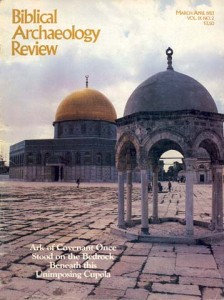Biblical Archaeology Review, March/April 1983
Features
“And David Sent Spoils … to the Elders in Aroer” (1 Samuel 30:26–28)
Excavators bring to life ancient Negev fortress but find no remains from David’s time
Three sites in the Bible—and perhaps foura—are called Aroer (pronounced Ah-roe-air). We call one Aroer of the Negev. The other two—or three—are east of the Jordan River. Aroer may mean “crest of a mountain.” This very general description would explain why several sites have this name. Or,...Read more ›
Where the Ancient Temple of Jerusalem Stood
Extant “foundation stone” for the Ark of the Covenant is identified
It is almost axiomatic among scholars that no trace of the Jewish Temple is to be found on Jerusalem’s imposing Temple Mount.1 “The Temple is gone. Not a stone, not a trace, remains,” wrote the venerable J. L. Porter in 1887.2...Read more ›
A BAR Editorial: Ancient Remains on the Temple Mount Must Not Be Destroyed
Any archaeological discussion of the Temple or its location on the Temple Mount invariably includes a statement to the effect that it would, of course, be unthinkable to conduct any archaeological excavations on the Temple Mount itself. We do not wish to think about the unthinkable, but,...Read more ›
BAR Jr.: Five Ways to Defend an Ancient City
“Walk about Zion … number her towers, consider well her ramparts, go through her citadels … ” (Psalms 48:12–13) What distinguished an ancient village or town from a city? One thing, perhaps the most important, was fortifications. Fortifying a settlement reflected the importance attributed...Read more ›

